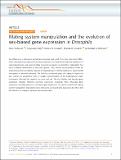Files in this item
Mating system manipulation and the evolution of sex-biased gene expression in Drosophila
Item metadata
| dc.contributor.author | Veltsos, Paris | |
| dc.contributor.author | Fang, Yongxiang | |
| dc.contributor.author | Cossins, Andrew R. | |
| dc.contributor.author | Snook, Rhonda R. | |
| dc.contributor.author | Ritchie, Michael Gordon | |
| dc.date.accessioned | 2017-12-12T16:30:13Z | |
| dc.date.available | 2017-12-12T16:30:13Z | |
| dc.date.issued | 2017-12-12 | |
| dc.identifier | 251539391 | |
| dc.identifier | be16385b-acc3-413d-a074-b4e3c054f727 | |
| dc.identifier | 85037721133 | |
| dc.identifier | 000417702300023 | |
| dc.identifier.citation | Veltsos , P , Fang , Y , Cossins , A R , Snook , R R & Ritchie , M G 2017 , ' Mating system manipulation and the evolution of sex-biased gene expression in Drosophila ' , Nature Communications , vol. 8 , 2072 . https://doi.org/10.1038/s41467-017-02232-6 | en |
| dc.identifier.issn | 2041-1723 | |
| dc.identifier.other | ORCID: /0000-0001-7913-8675/work/46761121 | |
| dc.identifier.uri | https://hdl.handle.net/10023/12318 | |
| dc.description | Funding: Natural Environment Research Council grant (NE/I014632/1) to MGR, RRS & ARC, and an associated NBAF award (NBAF654). | en |
| dc.description.abstract | Sex differences in dioecious animals are pervasive and result from gene expression differences. Elevated sexual selection has been predicted to increase the number and expression of male-biased genes, and experimentally imposing monogamy on Drosophila melanogaster has led to a relative feminisation of the transcriptome. Here, we test this hypothesis further by subjecting another polyandrous species, D. pseudoobscura, to 150 generations of experimental monogamy or elevated polyandry. We find that sex-biased genes do change in expression but, contrary to predictions, there is usually masculinisation of the transcriptome under monogamy, although this depends on tissue and sex. We also identify and describe gene expression changes following courtship experience. Courtship often influences gene expression, including patterns in sex-biased gene expression. Our results confirm that mating system manipulation disproportionately influences sex-biased gene expression but show that the direction of change is dynamic and unpredictable. | |
| dc.format.extent | 11 | |
| dc.format.extent | 1070295 | |
| dc.language.iso | eng | |
| dc.relation.ispartof | Nature Communications | en |
| dc.subject | QH301 Biology | en |
| dc.subject | QH426 Genetics | en |
| dc.subject | DAS | en |
| dc.subject | BDC | en |
| dc.subject | R2C | en |
| dc.subject.lcc | QH301 | en |
| dc.subject.lcc | QH426 | en |
| dc.title | Mating system manipulation and the evolution of sex-biased gene expression in Drosophila | en |
| dc.type | Journal article | en |
| dc.contributor.sponsor | NERC | en |
| dc.contributor.institution | University of St Andrews. School of Biology | en |
| dc.contributor.institution | University of St Andrews. Centre for Biological Diversity | en |
| dc.contributor.institution | University of St Andrews. Institute of Behavioural and Neural Sciences | en |
| dc.identifier.doi | 10.1038/s41467-017-02232-6 | |
| dc.description.status | Peer reviewed | en |
| dc.identifier.grantnumber | NE/I014632/1 | en |
This item appears in the following Collection(s)
Items in the St Andrews Research Repository are protected by copyright, with all rights reserved, unless otherwise indicated.

